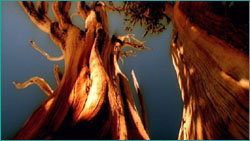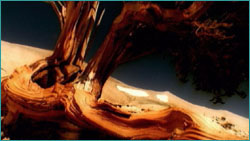|
 |
 |
|
|  Like tree, like needle:
Bristlecone needles may survive for as long as three or four decades.
Like tree, like needle:
Bristlecone needles may survive for as long as three or four decades.
|
A Tree's Secret to Living Long
Part 2 | Back to Part 1
A tree's tricks
Well, for starters, because bristlecones live where practically nothing else can,
little competition exists for water and nutrients. Bristlecone pines can liberally
spread their roots and expand their crowns, maximizing intake of these scant
resources. Sparse ground cover means the threat of fire is greatly reduced,
a danger further lessened by the relative paucity of dead bristlecone needles
in a landscape where trees are few and far between. Like the trees that produce
them, bristlecone needles are long-lived; they last up to 30 or 40 years.
While living bristlecone limbs thus carry a heavy load of needles, such a
stable needle mass may prove an advantage in the severe environment of the White Mountains.
Bristlecone rings, which vary in width year to year, reveal that the trees have an innate
ability to endure times of stress, such as a string of drought years. In such periods, the
species can go almost dormant. "There is something a little fantastic," wrote
Edmund Schulman in the March 1958 National Geographic, "in the persistent ability of a
4,000-year-old tree to shut up shop almost everywhere throughout its stem in a very
dry year, and faithfully to reawaken to add many new cells in a favorable year."
Another type of stress, one that torments most other plants, is virtually
absent among bristlecone pines: disease. The tree has a dense, highly resinous
wood that is a formidable barrier to invasion by insects and bacteria.
The resinous wood and the White Mountains' cool, dry climate also appear to
keep rot-causing fungi at bay, so that dead bristlecones sometimes stand for
several hundred years before toppling. In fact, the oldest bristlecone pines
live on the most exposed sites.
 Squat but steadfast, bristlecones put more stock
in surviving than in soaring.
Squat but steadfast, bristlecones put more stock
in surviving than in soaring.
|
|
Size matters (small size, that is)
Unlike their towering (and also long-lived) fellow conifers, the sequoias,
bristlecone pines put a greater premium on getting by than on getting big. The
tallest sequoia, a coast redwood found in Montgomery State Reserve near Ukiah,
California, is 367 feet tall. The tallest bristlecone pine is but 60 feet tall,
and most of its kind are much shorter. Clearly, bigger is not better in such a
brutal environment as that found at high altitude in the White Mountains,
where in cooler-than-average summers bristlecones get by on carbon compounds
produced that summer, but can only grow new tissue by tapping energy reserves
stored from the previous year.
Indeed, the bristlecone pine goes in for reduced size in a singular way. It is an
ability that, perhaps more than any other, allows the species, in standout cases,
to last longer than most civilizations. When a major root dies, through decay by
root-rot fungi or by exposure to desiccating winds, the sector of the trunk above
that root also succumbs, along with any branches served by that sector. In time,
the affected sector's bark falls off, leaving bare trunkwood. Some gnarled old
bristlecones have only a thin strip of living bark, which sustains a single
living branch and its needles. In a sense, these ancients have gone back to being seedlings.
|  Bristlecones that look almost dead may have been "almost dead" for
millennia.
Bristlecones that look almost dead may have been "almost dead" for
millennia.
|
You may ask, can such a thing—a snag with a fraction of itself in foliage—still be called a living tree? Well, if reproductive ability is a prerequisite
to being considered alive, then the answer is a resounding yes, for even the
hoariest bristlecones can generate cones with viable seeds. And however
truncated that tree is, it is still the very same tree that was a seedling
when, say, King Tut was a boy.
Now, if only King Tut and the rest of us brief-lived humans could have figured out a
way to hang on so long.
Peter Tyson is editor in chief of NOVA Online.
Further reading
Lanner, Ronald M. 1999. Conifers of California. Los Olivos, Calif.: Cachuma Press, pp. 47-51.
Mohlenbrock, R.H. 1985. "Ancient Bristlecone Pine Forest, California."
Natural History 94(5): 38-41.
Schmid, R. and M.J. "Living Links With the Past." Natural History 84(3):
38-45.
Schulman, E. 1958. "Bristlecone Pine: Oldest Known Living Thing." National
Geographic Magazine 113(3): 354-372.
Photo credits
Explore the Methuselah Grove |
A Tree's Secret to Living Long
Build a Tree-Ring Timeline |
Illuminating Photosynthesis
Resources |
Teacher's Guide |
Transcript |
Site Map |
Methuselah Tree Home
Search |
Site Map |
Previously Featured |
Schedule |
Feedback |
Teachers |
Shop
Join Us/E-Mail |
About NOVA |
Editor's Picks |
Watch NOVAs online |
To print
PBS Online |
NOVA Online |
WGBH
© | Updated December 2001
|
|
|
|